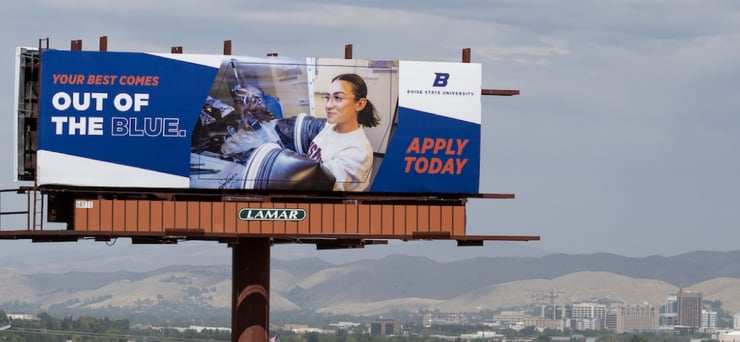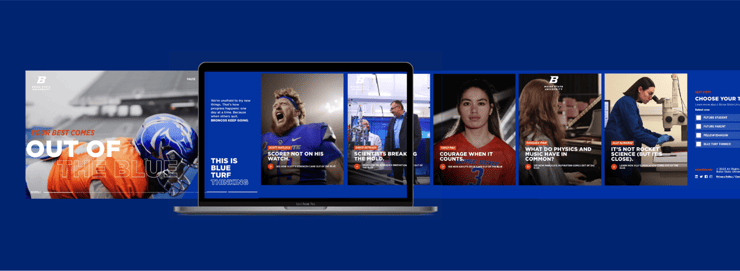What I Came Away Thinking After AMA
Like a lot of you, I just spent three days at AMA in Orlando. I heard about Facebook and mobile and automation and personalization. I heard about leadership and culture and generations and empathy. I heard about the impact of education on our society. And it was all great (minus Facebook tbh), as it always is. But all of the talks and conversations tend to spin me around. There's so much, and I find myself asking: What did I miss? Was there a common theme? Was there something that connects everything we just heard and talked about? What was different than in years past? Are we evolving fast enough as an industry or just talking about the same things year after year?
The last question at first caused me to pause. And then it gave me hope. It's easy to say that higher ed moves slow. And even easier to use that as an excuse for becoming complacent. But when you drown out the noise in your head, things become clear. No matter how slow or fast we move, there is always a constant. And there always will be. It’s humans. And more importantly, the human condition.
As marketers, we are trained to create things that are fundamentally designed to elicit an emotion. To cause someone to recall something. To get them to like us more. And we have been sucked in by the allure of efficiency and automation. To make things easier and faster. There may be some good in that approach, but the only thing I can guarantee you about that approach is that we’ll just do a nuanced version of it next year. We’ll dive back into Google Analytics or Sprout or {insert favorite dashboard here} and make a goal to eclipse a number we just looked at on a glowing rectangle. I can’t think of a worse way to elicit an emotion from someone. On top of that, our goal should never just be to elicit an emotion from someone. It's short-sighted and the intent is awful.
Our primary goal as communicators and marketers should be about genuine human connection. It's the only way to build a sustainable movement. We all long to be listened to, to be loved and needed, and to feel like we are on a path towards self-improvement. Universities can impact these deep desires every single day. And they can do it across all of their constituencies. Current students, prospects, alumni, faculty – there is an opportunity to build genuine connection every day. But it is hard. And it's almost always immeasurable.
So, we focus on marketing tactics that will only take us so far because, at some level, they are measurable. Advertisements, brand anthem videos, campus banners, virtual tours, Instagram stories, and direct mail build awareness in the short-term. Sometimes they'll increase the likelihood to inquire or apply. But not as well as a person can. Especially not face-to-face. If you think about an interpersonal communication effort like that across a university, it seems far too daunting (more on this in a bit). It's a lot of conversations that you'll never be 100% sure are working. This amount of effort and ambiguity is exactly what technology tells us we don't need. It tells us, with quantifiable metrics, that what we are doing is working just fine and with minor adjustments, we can be doing even better. Numbers are like an electric blanket though. One minute you're cozy and three episodes deep on Netflix, and the next minute your living room is on fire.
I'm not saying that we should stop marketing campaigns. Or that we shouldn't automate some of our efforts. Campaigns, automation, and measurement are vital. What I am saying is that should never be our core focus. We should question where we focus our efforts and have the confidence to put time into efforts that require us to listen, engage, and learn from the people all around us. I wish I had more definitive answers to help, but I only have more questions. Like:
- Are we better off creating a new virtual tour that we'll know exactly how many people took? Or should we set up a workshop for admissions counselors and tour guides that allows them to design a new tour?
- Should we develop a social media strategy for the President? Or should we find more intentional, one-on-one interactions for her to not just share her vision, but learn from others on how to make it even more impactful?
- Should we do another crowdfunded Give Day? Or, do we work directly with local alumni groups and let them create new opportunities for giving that align with their ideas of how their alma mater can make a bigger impact?
Those would all be difficult decisions. And it's easy to poke holes in any of those ideas; to find reasons they just won't work. At some point, though, you do have to make a decision and too often we default to the one we'll be able to measure. But the other road, the one less measurable, works. And here's proof.
A few years ago, I started working on a project with Tyler Gayheart at the University of Kentucky. He oversaw strategic communications for enrollment management. The project was to build a majors and minors finder app. Kentucky was embarking on a significant effort to reduce the number of students who were still undeclared. In one way, building a majors and minors finder is pretty straightforward. But we started differently. We wrote a story. That of a 16-year-old girl who built rockets with her dad growing up, who now wanted to be an astronaut. The app was designed and developed with her in mind. At every turn, we asked, how will she use this? Will she find a program at Kentucky that can set her on a course to living out her dream? And while the app functioned beautifully, it was successful because Tyler never saw it as an app. He saw it as a medium for face-to-face communication between people and a way for people at Kentucky to help students find direction and value. So much so that he spent six-plus months all over campus talking to deans, faculty, counselors, students, etc. about the app, why it was created, and how to use it. What happened? Counselors turned their computers towards students, walked them through the app, and had real conversations about the best options available. Within the first year, undeclared majors at Kentucky dropped by nearly 20%.
Tyler didn't set out on that project to hit a specific number. He set out to increase the chances that more students would graduate by helping them find what they were passionate about. And the best way wasn't to build an app, it was to build real human connections.











